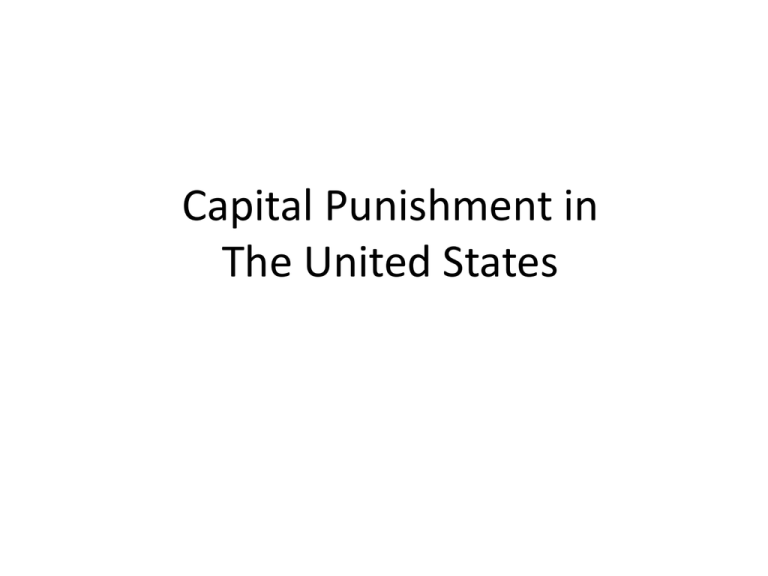Capital Punishment PPT
advertisement

Capital Punishment in The United States Capital Punishment (the death penalty) is a legal option for sentencing in 32 states. The federal government and the military also allow for death sentences. Texas leads the nation with the highest number of executions. Oklahoma has the most executions per capita. Some states have the death penalty, but do not use it in practice. These states are said to have a “moratorium”. Kansas and New Hampshire have not used the death penalty since reinstatement. Pennsylvania, Connecticut, Oregon, and New Mexico have only executed prisoners who have dropped their appeals and “volunteered” to be executed. Murder and Executions Capital punishment is statistically unusual. There is one execution for every 700 murders. There is one execution for every 325 murder convictions. Over 98% of those executed are men. Race and Death Since 1976, 34% of those executed were black. In 2010, blacks made up only 13% of the U.S. population. The race of the victim is significant. Eighty percent of executions involved a White murder victim. This occurs even though murders of Black and White victims are nearly equal. Mental Anguish The condemned prisoner is under extreme mental pressures as the judicial process can last for years. The suicide rate of those on death row is about 10x higher than the general population. Public executions are considered to be a violation of the Eighth Amendment. However, every state that has the death penalty allows for witnesses including representatives of the victim, the condemned and the media. Filming or pictures of executions are not allowed, but closed circuit television has been used when there are too many witnesses. Historically, methods of execution in the United States or the colonies included hanging, firing squad, gas chamber, burning, electrocution, drowning or crushing. Past executions have often been specific to cultural beliefs. Drowning was once an accepted punishment for witches. In Utah, the firing squad was once considered an appropriate method due to the doctrine of “blood atonement”. Currently, the first choice method in each state is lethal injection, but many states have backup methods including electric chair, gas chamber, and hanging. In 1972, the Supreme Court (Furman v. Georgia) ruled that executions violated the Eighth Amendment because there was too much inconsistency as to who received it. The Supreme Court did not say that executions themselves were unconstitutional. Between 1972 and 1976 there was a moratorium on executions while states rewrote their death penalty laws to make them narrower. In general the court must find a person guilty of a crime for which the death penalty is prescribed (eligibility). Secondly, the court must select the death penalty in a (usually) separate phase for sentencing. The lethal injection protocol has been challenged in court, but the Supreme Court ruled that it was not a violation of the Eighth Amendment in Baze v. Rees (2008). The ruling upheld Kentucky’s lethal injection protocol which used the same drugs used in all states that had lethal injection at the time. This protocol uses three drugs… 1. The first drug puts the condemned to sleep 2. The second drug paralyzes lung function 3. The third drug stops the heart. More recently, lethal injection has been challenged not by the courts, but by nations and companies that have refused to sell drugs for the purposes of execution or torture. This has slowed the number of executions in many states while others have began trying different methods (drugs) in their executions. Opponents to execution say that… • • • • Other nations are no longer using the death penalty Execution itself is “cruel and unusual” The condemned may feel pain but be unable to express it Sometimes executions are botched when needles are poorly placed Proponents of execution point out that… • Western civilization has a long history of using the death penalty • Medical science has shown the drugs to be quick and reliable • The Supreme Court has not ruled against executions in general











